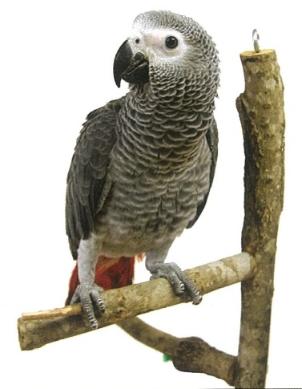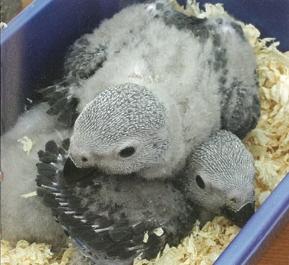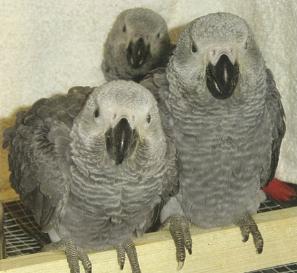Grey parrots use holes in trees for their nests. Generally these are existing holes, high up in the trunk of a tree. Often, an existing hole is enlarged and the birds are easily capable of excavating these using their powerful beaks. They also use their feet to help enlarge the hole. The birds do not carry any material to the nesting hole; the eggs, two to four, are laid on the wood chippings of the floor of the hole. The female takes on most of the responsibility for incubation and caring for the chicks, but males do help as well. The male will return regularly to feed his mate on regurgitated food, which he stores in his crop. This is vital for the female when she is incubating the eggs and brooding the very young chicks.
Chicks call before hatching
After about 25 days' incubation, the chicks start to call from within the egg as they begin to establish their contact calls with their parents. The eggs will then hatch two or three days later. The chicks emerge blind and partially covered in grey down feathers. At this age they are completely dependent on their parents for all their needs. The parents feed the chicks on partially digested regurgitated food and the babies develop quite rapidly. Usually they are ready to take their first flight and leave the nest (to fledge) by about 13 weeks of age. At this age the young birds are extremely naive. They are very vulnerable to attacks from predators and still quite incapable of feeding themselves. While the urge to fly is very strong in the birds at this age, their first few flights are clumsy as the skills of flying can only be developed by trial and error. The young birds will stay with their parents for many months as they learn which things to eat, what to avoid and how to take the appropriate action at the sight of predators or threats. The process of becoming independent of their parents is a protracted affair and these youngsters remain highly reliant on their parents and other flock members for their own safety for up to a year. Many recently fledged birds fail to survive but those who learn fast, remain alert at all times and develop their flying skills rapidly stand a good chance of surviving. At three or four years of age they are sexually mature and will begin attempts to breed, but this depends on finding a suitable nesting hole.
Note the dark, almost black,
eye of this very young African grey,
when the bird is five months old,
the eyes turn pale grey, later
still becoming straw-yellow.


The chicks above are about two weeks old.

At six weeks, their first true feathers
are growing through.
are growing through.

After eight weeks,
the lose most of their down feathers.
the lose most of their down feathers.